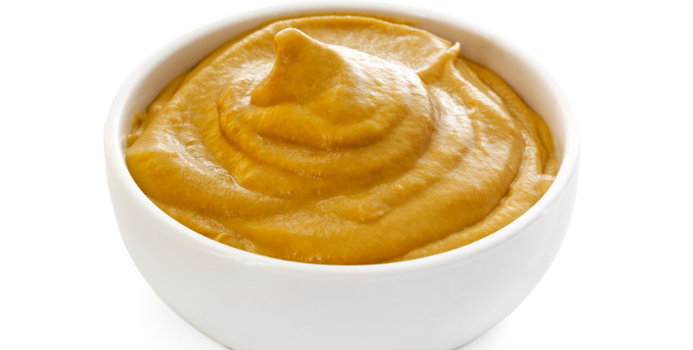Mustard is a popular condiment that is made by crushing or grinding mustard seeds and then mixing with water, vinegar and other flavorings and spices. Mustard is a low-calorie, flavorful addition to many foods, including as a spread on sandwiches and hamburgers or as an ingredient in sauces and marinades.
Types of Mustard
Mustard seeds used in cooking and food preparation come from three different plants: black mustard (Brassica nigra), brown Indian mustard (Brassica juncea) and white mustard (Brassica hirta/Sinapis alba). The plants grow well in temperate regions and the major producers include Canada, Hungary, Great Britain, India, Pakistan and the United States.
The mustard seed itself contains 35 calories, 2.6 grams of protein, 2.2 grams of fat and 2.6 grams of carbohydrate in each portion of two teaspoons. The seeds also contain dietary fiber when consumed whole, contributing 1 gram or 4 percent of the recommended daily value.
Mineral Contents
Mustard seeds are a particularly good source of the mineral selenium, providing almost 15 percent of the daily value for adults as recommended by the Food and Nutrition Board of the Institutes of Medicine. This trace mineral is essential to health because of its antioxidant properties. Antioxidants are nutritional compounds that help prevent cellular damage from free radicals-natural byproducts of metabolism that are believed to contribute to the development of chronic diseases such as cancer and heart disease.
Phytonutrients
Brassica plants are also known for being plentiful in glucosinolates, which are phytonutrients that are being studied for their anti-cancer effects. In animal studies, intake of glucosinolates has been shown to inhibit the growth of existing cancer cells and may be protective against the formation of new mutations.
Fatty Acids
Mustard seeds are a surprisingly good source of omega-3 fatty acids. These are considered essential for human health, particularly in the growth and development of healthy brain tissue. Omega-3 fatty acids have also been studied for their role in reducing the risk of heart disease, particularly when these unsaturated fats replace saturated fats in the diet.
Nutrition Based on Type of Mustard
Nutritionally, the value of mustard is dependent upon the type of mustard that is made and the ingredients used in processing. Some of the most common mustard types available in the United States are yellow mustard, deli-style or brown mustard, Dijon mustard, honey mustard and stone-ground or whole-grain mustard.
Honey mustard, for example, contains twice as many calories as either yellow or brown mustard because of the addition of honey, a simple sugar. One tablespoon of honey mustard may contribute as much as 25 calories, while yellow mustard only contains 11 calories per serving. Brown mustard contains approximately 14 calories per tablespoon.
Mustard is often promoted as a smart diet choice when used as a substitute for mayonnaise, because it is lower in fat and calories. However, those who are following a sodium-restricted diet, such as patients with high blood pressure or kidney disease, should read nutrition labels carefully for salt content. One tablespoon of either yellow or brown mustard can contain up to 200 milligrams of sodium, almost 8 percent of the recommended intake of 2,400 milligrams.



